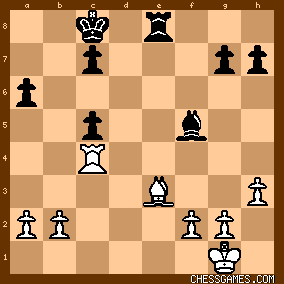| May-19-04 | | Hanzo Steel: This is a solid demonstration of the Exchange Variation by Larsen against 5. ... Qd6. Larsen simultaneously disposes of Portisch's double bishop advantage and simplifies into an end game that favors white. This game is from their candidates match, which Portisch won. Portisch had a lot of experience with this opening and was able to draw with the more solid 5. ... f6 in his next game with the black pieces. |
|
| Dec-22-13 | | Poisonpawns: Brilliant! and timely exchange sacrifice by Larsen.One of his great games. I enjoyed how Larsen skillfully avoided the exchange of Rooks for a long time as the opposite colored Bishops would probably lead to a draw. Larsen keeps fighting, and then at the right time gives up the exchange to enter a winning Bishop and pawns vs Rook ending. |
|
| Jan-17-15 | | nummerzwei: What on earth was 23...b5? Afterwards Black has to cope with pawn weaknesses on the queenside and ultimately loses a pawn. With 23...b6 he should be able to safely steer the game to the drawing haven.
'Having to win' can be ruled out as an explanation seeing that Portisch was in the lead by 3-1 and should have been more than happy to draw with Black. |
|
| Jan-17-15 | | Howard: Nummerzwei may be interested to know that in Chess life and Review (as it was called back in those days), Pal Benko covered this match. There was a point in the above game (and it was probably regarding 23...b5, though I don't have that particular issue in front of me right now) where Portisch blundered and Benko made the comment, "Portish returns Larsen's blunder in the previous game but this is taking common courtesy too far." Yes, I do recall Portish's making at least one big mistake in this game though it's been over 20 years since I looked at it. |
|
| Jan-17-15 | | nummerzwei: Thanks for your reply, Howard. I've just read on the CG match page that around this game Portisch got sick leading to the postponement of several games including this one.
This may explain his urge to trade down to a draw as fast as possible with 23...b5?.
On the other hand, I don't understand at all why the same report labels this
as one of Larsen's best games. |
|
| Jan-17-15 | | Howard: Hmmm....don't recall Portisch's becoming ill, but when I get home (I'm at the library right now.) I'll dig out that 1977 volume of Chess Life & Review, to read up on it. It covered the match very thoroughly, but then the Internet hadn't been invented yet back in those days.... Regarding your comment about this game being "one of Larsen's best games", I, too, would question that. This game was basically decided on Portisch's blunder. Check out, though, Game 3. Now, that was one of Larsen's better games from that time period---long, slightly boring endgame, but it was also an example of squeezing out a win from a rather miniscule advantage. |
|
| Oct-22-15 | | zanzibar: Indeed, <nummerzwei> identifies Black essentially self-destructing on the Q-side: (After 23...b5? 24.Re1-c1 bxc4?! 25.Rxc4)

click for larger viewBlack has self-destructed the Q-side for what reason? The eval marks are for GM level of play, but it's clear the c-pawn is blockaded and falls. Very hard to explain give 23...b3 and White has no lsb to exploit weaknesses. Given 23...b4, Black could make the following attempt to at least battle on the Q-side. It's a bit technical, but worth showing: 24...b4 25.Bxc5 Re2 26.a3 b3 27.Bd4 g6

click for larger viewBlack has some compensation for the pawn. |
|
| Oct-22-15 | | zanzibar: Two rounds later the two repeated another Exchange, but this time Portisch played a Gligoric with 5...f6, 6...Bg4: Larsen vs Portisch, 1977
That game was a draw. |
|





